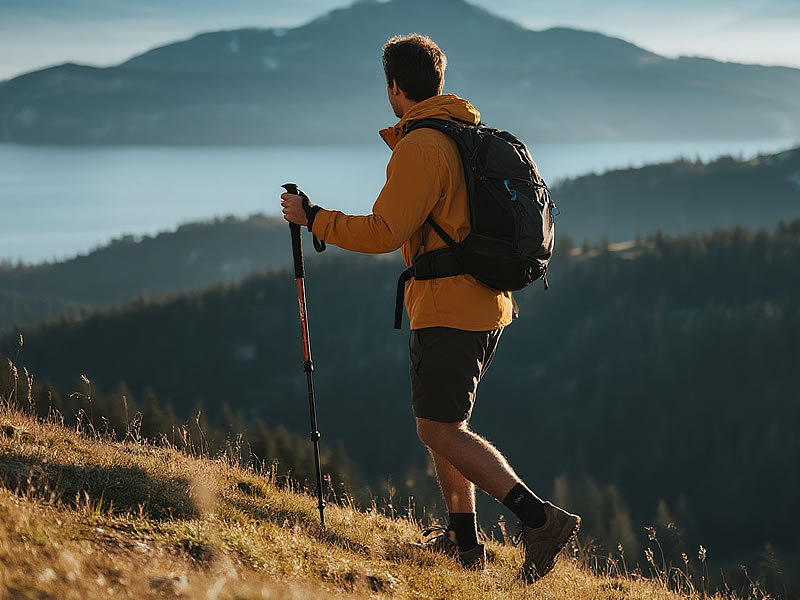What are the benefits of using trekking poles for hiking?
Trekking poles are far more than simple accessories—they’re transformative tools that elevate safety, endurance, and performance on trails. Backed by biomechanics research and seasoned hiker testimonials, their advantages extend beyond mere balance. Here’s why they’re indispensable for modern hiking:

🦵 1. Joint Protection: Science-Backed Shock Absorption
- Knee Stress Reduction: Studies show poles reduce knee impact by 20–30% during descents, critical for preventing osteoarthritis or chronic pain (University of Salzburg, 2017).
- Ankle & Hip Relief: By distributing weight across four points (vs. two), poles decrease compressive forces on lower-body joints, especially with heavy packs.
- Longevity: Regular pole users report fewer overuse injuries, extending hiking endurance over multi-day trips.
⚖️ 2. Enhanced Stability: Conquer Technical Terrain
- Slip Prevention: On wet rocks, mud, or loose scree, poles provide 3 additional contact points, reducing fall risk by up to 47% (Appalachian Trail Conservancy data).
- Stream Crossings: Probe water depth and stabilize against currents—essential for solo hikers.
- Weight-Shifting: Navigate steep inclines confidently by planting poles at 45° angles for leverage.
⚡ 3. Endurance Boost: Efficiency Through Biomechanics
- Uphill Propulsion: Engaging arms and shoulders converts upper-body strength into forward momentum, cutting perceived effort by 25% (Journal of Sports Sciences).
- Rhythmic Pacing: Synchronized pole planting improves cadence, reducing muscle fatigue on long flats.
- Downhill Control: Braking with poles spares quadriceps, preventing "jelly legs" during descents.
🛠️ 4. Multifunctional Versatility
- Shelter Setup: Convert poles into tent/tarp supports (e.g., for trekking pole tents like Zpacks Duplex).
- Trail Clearing: Part foliage or test unstable ground (e.g., snow bridges).
- Wildlife Safety: Create noise in bear country or ward off aggressive animals.
📊 Technical Comparison: Pole Materials & Features
| Feature | Carbon Fiber (e.g., Black Diamond Distance Z) | Aluminum (e.g., LEKI Cressida) |
|---|---|---|
| Weight | 280–400g/pole (ultralight) | 450–600g/pole (durable) |
| Shock Absorption | Low vibration; stiff for speed | Natural flex; better impact dampening |
| Durability | Prone to snapping under torsion | Bends but rarely breaks |
| Best For | Fastpacking, weight-sensitive hikers | Rough terrain, heavy loads |
🔧 Maximizing Benefits: Technique Tips
- Correct Length: At 90° elbow bend, poles should touch ground when standing upright. Shorten for climbs, lengthen for descents.
- Wrist Strap Use: Slide hand up through strap, then grip—transferring load to wrists, not palms.
- Rhythm Syncing: Plant pole opposite to forward foot (right pole + left foot) for natural gait.
- Terrain Adaptation:Uphill: Shorten poles; push down/back for thrust.Downhill: Lengthen poles; plant ahead for braking.Sidehills: Adjust lengths for uneven ground.
⚠️ Safety Considerations
- Collapsible Poles: Fold during scrambles to avoid snagging.
- Tip Maintenance: Replace worn carbide tips (e.g., Black Diamond replacements) for reliable traction.
- Group Hiking: Maintain distance to prevent tripping others.
🌱 Eco-Impact & Innovations
- Recycled Materials: Brands like Komperdell use 80% recycled aluminum.
- Cork Grips: Biodegradable, moisture-wicking, and mold-resistant (e.g., REI Co-op Traverse).
- FlickLock vs. TwistLock: FlickLock systems (LEKI) offer quicker, more reliable adjustments than twist mechanisms in cold/wet conditions.
💎 The Verdict: Why Every Hiker Should Use Poles
Trekking poles are force multipliers—enhancing stability, accelerating pace, and protecting joints across all terrains. For day hikers, they prevent fatigue; for thru-hikers, they’re injury-prevention essentials. Invest in adjustable, carbide-tipped poles (carbon for speed, aluminum for robustness), master proper technique, and experience trails with renewed confidence and endurance.
"My poles turned the Colorado Trail from agony into adventure. They carried 30% of my weight—and 100% of my trust." — Jenna Thorne, Triple Crowner (AT, PCT, CDT)
Pro Tip: Test poles on short hikes first to refine your rhythm. Your knees (and pace) will thank you! 🏔️






